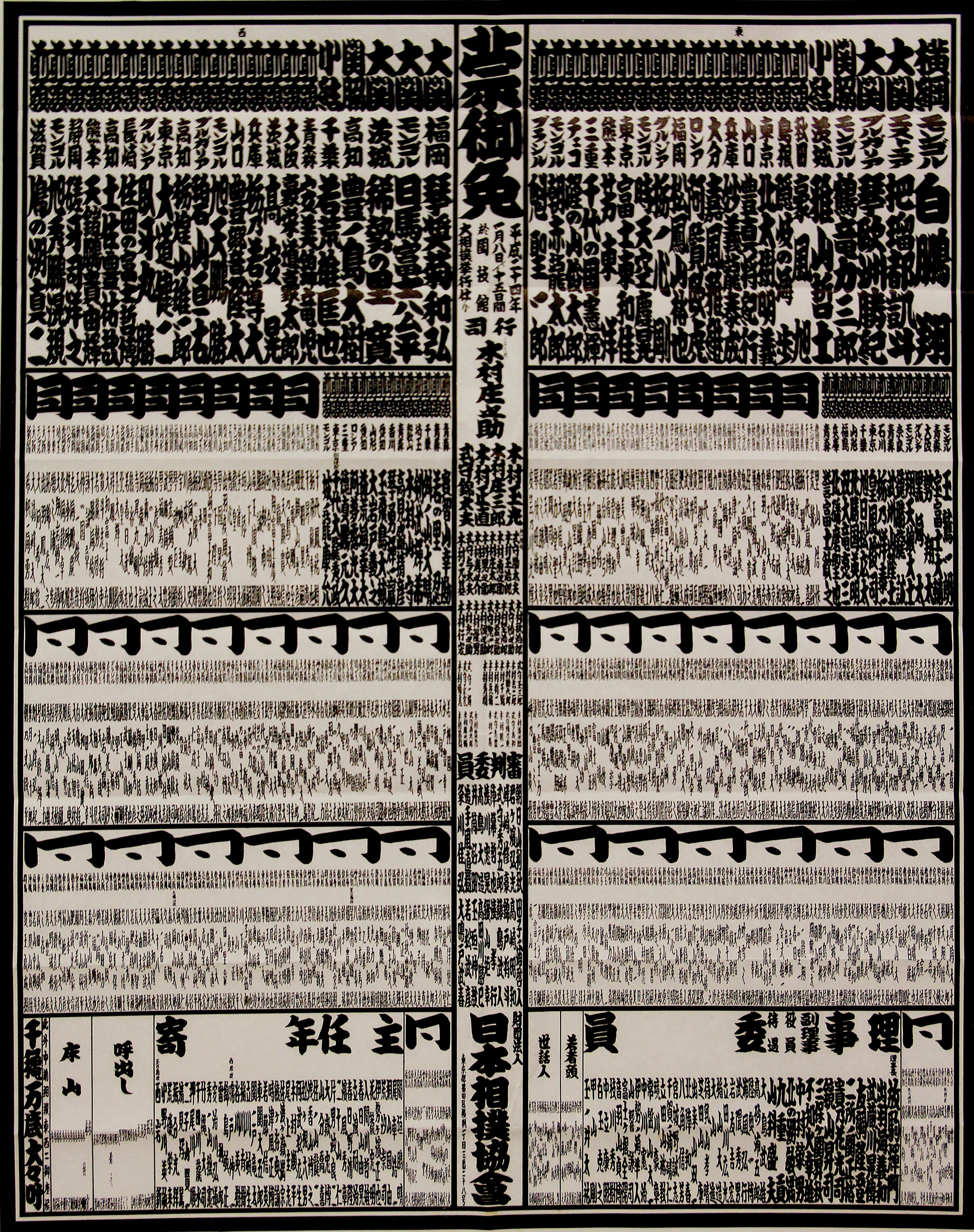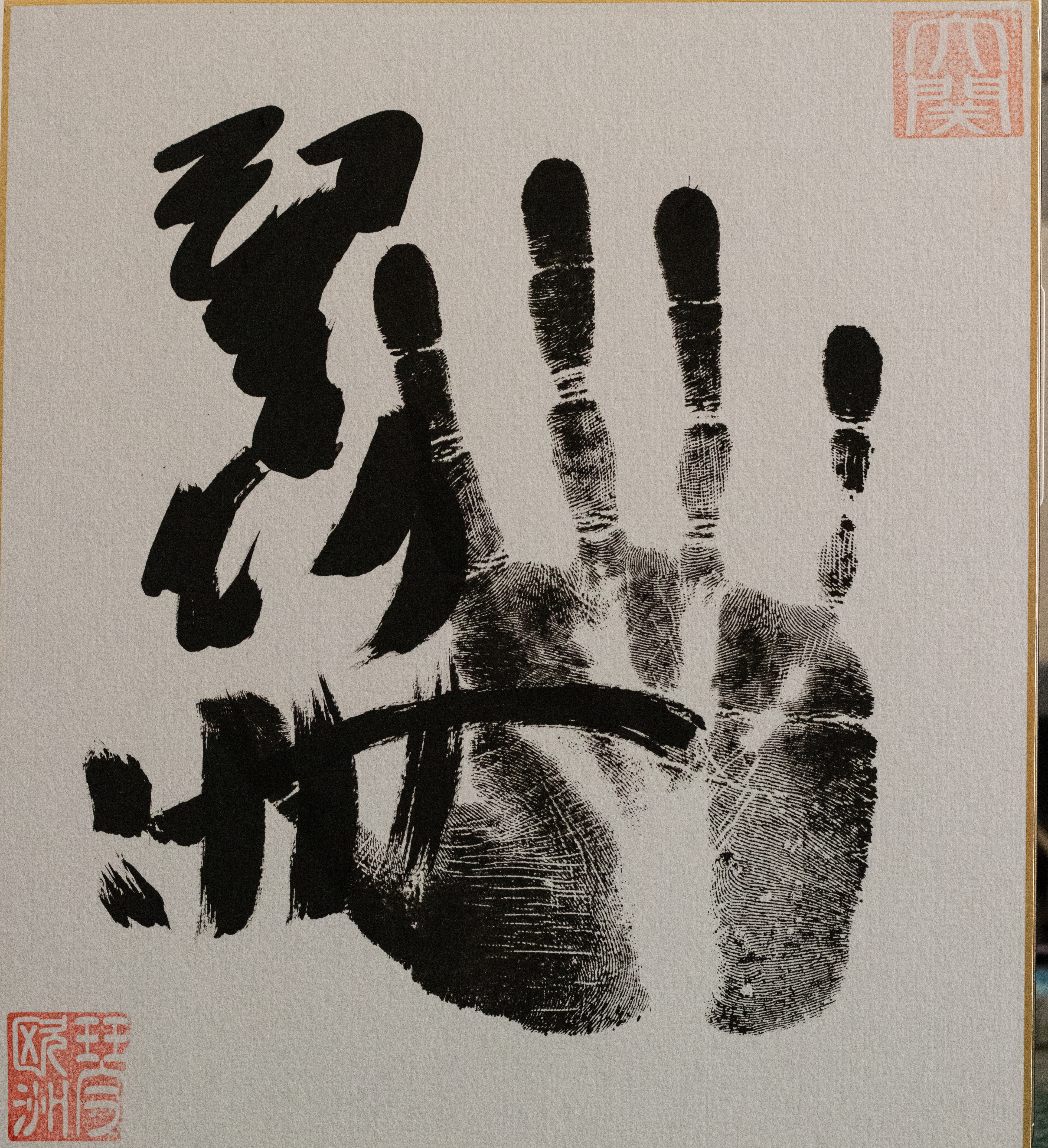|
Aran Hakutora
, image= Aran 2008 Sep.jpg , birth_name = Alan Gabaraev , birth_date = , birth_place = Vladikavkaz, North Ossetian ASSR, RSFSR, USSR , height = , weight = , heya = Mihogaseki , rank = , record = 263-258 , debut = January 2007 , highestrank = Sekiwake (September, 2010) , retireddate = October 2013 , yushos = 1 (Jūryō)1 (Jonokuchi) , prizes = Fighting Spirit (2) , goldstars = , update = Feb 2, 2015 is a Russian former sumo wrestler.http://sumodb.sumogames.com/Rikishi.aspx?r=6771 He began his professional career in January 2007 and made the top division in a record eleven tournaments. The highest rank he reached was ''sekiwake''. He was runner-up in consecutive tournaments in May and July 2010 and earned two '' sanshō'' or special prizes for Fighting Spirit. He wrestled for Mihogaseki stable. Career Aran was born in Vladikavkaz, North Ossetia–Alania, RSFSR, USSR, the same area as Rohō and Hakurozan. He began as an amateur wrestler, winning the Russian ... [...More Info...] [...Related Items...] OR: [Wikipedia] [Google] [Baidu] |
Vladikavkaz
Vladikavkaz (russian: Владикавка́з, , os, Дзæуджыхъæу, translit=Dzæwdžyqæw, ;), formerly known as Ordzhonikidze () and Dzaudzhikau (), is the capital city of the North Ossetia-Alania, Republic of North Ossetia-Alania, Russia. It is located in the southeast of the republic at the foothills of the Caucasus Mountains, situated on the Terek River. The city's population was 311,693 as of the Russian Census (2010), 2010 Census. As a result, Vladikavkaz is one of the most populous cities in the North Caucasus region. The city is an Industrial sector, industrial and transport, transportation centre. Manufactured products include processed zinc and lead, machinery, chemical substance, chemicals, clothing and food products. Etymology From 1931 to 1944 and from 1954 to 1990, its name in both Russian and Ossetic languages was ''Ordzhonikidze'' () (after Grigory Ordzhonikidze, Sergo Ordzhonikidze, a Georgian Bolshevik), and from 1944 to 1954 it was officially called ... [...More Info...] [...Related Items...] OR: [Wikipedia] [Google] [Baidu] |
Baruto
Kaido Höövelson, (known professionally as Baruto Kaito ; born 5 November 1984) is an Estonian politician and former professional sumo wrestler. Making his debut in May 2004, he reached the top division after just two years in sumo in May 2006. After suffering a number of injury problems in 2007 which delayed his progress, he reached the third-highest rank of ''sekiwake'' in November 2008, and was promoted to '' ōzeki'' rank after finishing the March 2010 tournament with a score of 14–1. He was a tournament runner-up four times before recording a top division championship in the 2012 January tournament. During his career Baruto also earned five special prizes for Fighting Spirit, one for Outstanding Performance and one for Technique. He lost his ''ōzeki'' rank after more injury problems at the end of 2012, and having fallen greatly in rank after withdrawing from the May 2013 tournament, he announced his retirement in September of that year at the age of 28. After retiremen ... [...More Info...] [...Related Items...] OR: [Wikipedia] [Google] [Baidu] |
Banzuke
A , officially called is a document listing the rankings of professional sumo wrestlers published before each official tournament (''honbasho''). The term can also refer to the rankings themselves. The document is normally released about two weeks before the tournament begins. On the ''banzuke'', wrestlers are divided into East, which is printed on the right, and West, which is printed on the left. Each wrestler's full ''shikona'' (ring name), hometown and rank is also listed. The top of the page starts with the highest ranked ''makuuchi'' wrestlers printed in the largest characters, down to the wrestlers in the lowest divisions which are written in much smaller characters. The names of ''gyōji'' (sumo referees), ''yobidashi'' (ushers/handymen), '' shimpan'' (judges), ''oyakata'' (elders of the Japan Sumo Association), and occasionally ''tokoyama'' (hairdressers) are also listed. While not as old as sumo itself, the form and production of this document can be traced as fa ... [...More Info...] [...Related Items...] OR: [Wikipedia] [Google] [Baidu] |
Sumo May09 Aran
is a form of competitive full-contact wrestling where a ''rikishi'' (wrestler) attempts to force his opponent out of a circular ring (''dohyō'') or into touching the ground with any body part other than the soles of his feet (usually by throwing, shoving or pushing him down). Sumo originated in Japan, the only country where it is practiced professionally and where it is considered the national sport. It is considered a ''gendai budō'', which refers to modern Japanese martial arts, but the sport has a history spanning many centuries. Many ancient traditions have been preserved in sumo, and even today the sport includes many ritual elements, such as the use of salt purification, from Shinto. Life as a wrestler is highly regimented, with rules regulated by the Japan Sumo Association. Most sumo wrestlers are required to live in communal sumo training stables, known in Japanese as ''heya'', where all aspects of their daily lives—from meals to their manner of dress—are dict ... [...More Info...] [...Related Items...] OR: [Wikipedia] [Google] [Baidu] |
Kotoōshū Katsunori
Kotoōshū Katsunori ( ja, 琴欧洲 勝紀) (legal name: Karoyan Andō, born February 19, 1983 as Kaloyan Stefanov Mahlyanov, bg, Калоян Стефанов Махлянов) is a former professional sumo wrestler or ''rikishi'' from Bulgaria. He made his debut in 2002, reaching the top division just two years later. In 2005, he reached the rank of '' ōzeki'' or 'champion', the second-highest level in the sumo ranking system behind only ''yokozuna.'' On May 24, 2008, Kotoōshū made history by becoming the first European sumo wrestler to win an Emperor's Cup. He was one of the longest serving ''ōzeki'' in sumo history, holding the rank for 47 consecutive tournaments until November 2013. In January 2014 Kotoōshū obtained Japanese citizenship, a requirement of becoming an elder in the Japan Sumo Association, and he announced his retirement during the following tournament in March. In April 2017 he opened his own training stable, Naruto. Early life and sumo background He wa ... [...More Info...] [...Related Items...] OR: [Wikipedia] [Google] [Baidu] |
List Of Sumo Record Holders
This is a list of records held by wrestlers of professional sumo. Only performances in official tournaments or ''honbasho'' are included here. Since 1958 six ''honbasho'' have been held every year, giving wrestlers from the modern era more opportunities to accumulate championships and wins. Before this, tournaments were held less frequently; sometimes only once or twice per year. Names in bold indicate a still active wrestler. The tables are up to date as of the end of the November 2022 tournament. Most top division championships Most career championships + Raiden is said to have had the best record in 28 tournaments between 1790 and 1810, Tanikaze 21 between 1772 and 1793, and Kashiwado 16 between 1812 and 1822. Tachiyama won two unofficial championships and nine official, giving him a total of 11. Most undefeated championships + Tournaments have been consistently fifteen days long since May 1949. Before that date there were a number of different lengths, including ... [...More Info...] [...Related Items...] OR: [Wikipedia] [Google] [Baidu] |
Makuuchi
, or , is the top division of the six divisions of professional sumo. Its size is fixed at 42 wrestlers (''rikishi''), ordered into five ranks according to their ability as defined by their performance in previous tournaments. This is the only division that is featured on NHK's standard live coverage of sumo tournaments. The lower divisions are shown on their satellite coverage, with only the ''makuuchi'' broadcast having bilingual English commentary. ''Makuuchi'' literally means "inside the curtain", a reference to the early period of professional sumo, when there was a curtained-off area reserved for the top ranked wrestlers, to sit before appearing for their bouts. Wrestlers are considered for promotion or demotion in rank before each grand tournament according to their performance in the one previous. Generally, a greater number of wins than losses (''kachi-koshi'') results in a promotion, and the reverse (''make-koshi'') results in demotion. There are stricter criteria ... [...More Info...] [...Related Items...] OR: [Wikipedia] [Google] [Baidu] |
Cannabis (drug)
Cannabis, also known as marijuana among List of names for cannabis, other names, is a psychoactive drug from the cannabis plant. Native to Central or South Asia, the cannabis plant has been used as a drug for both Recreational marijuana, recreational and Entheogenic use of cannabis, entheogenic purposes and in various traditional medicines for centuries. Tetrahydrocannabinol (THC) is the main psychoactive component of cannabis, which is one of the 483 known compounds in the plant, including at least 65 other cannabinoids, such as cannabidiol (CBD). Cannabis can be used by Cannabis smoking, smoking, Vaporizer (inhalation device), vaporizing, Cannabis edible, within food, or Tincture of cannabis, as an extract. Cannabis has various effects of cannabis, mental and physical effects, which include euphoria, altered states of mind and Cannabis and time perception, sense of time, difficulty concentrating, Cannabis and memory, impaired short-term memory, impaired motor skill, body mo ... [...More Info...] [...Related Items...] OR: [Wikipedia] [Google] [Baidu] |
Wakanohō Toshinori
Wakanohō Toshinori (born July 8, 1988 as Soslan Aleksandrovich Gagloev (russian: Сосла́н Алекса́ндрович Гагло́ев)) is a retired Russian sumo wrestler. His highest rank was ''maegashira'' 1. He became the first active wrestler to be dismissed from sumo, after being arrested for possession of cannabis in August 2008. He has also played college football at the University of South Florida, Webber International University, and Warner University. As of July 2014, he lives in Florida. Career He was a freestyle wrestler in Russia, but as his weight continued to increase past the upper limit for competitions, he switched to sumo. Having known fellow Russian sumo wrestler Rohō for many years, when he first arrived in Japan he stayed at Rohō's training stable, Ōtake-beya, for about six months to learn the basics. Due to the restrictions on foreigners, he could not join that stable, but its stablemaster Taihō had connections to the former Wakanohana Kan ... [...More Info...] [...Related Items...] OR: [Wikipedia] [Google] [Baidu] |
Sekitori
A ''sekitori'' (関取) is a ''rikishi'' (力士, sumo wrestler) who is ranked in one of the top two professional divisions: ''makuuchi'' and ''jūryō''. The name literally translates to having taken the barrier, as only a relatively small fraction of those who enter professional sumo achieve ''sekitori'' status. Currently there are 70 ''rikishi'' in these divisions. The benefits of being a ''sekitori'' compared to lower ranked wrestlers are significant and include: * to receive a salary and bonus (those in the lower divisions merely receive an allowance) * to have one's own supporters' club * to wear high quality men's kimono and other items of attire * to have a private room in the training stable * to be able to get married and live away from the training stable * to have junior ''rikishi'' to effectively act as their personal servants * to wear a silk ''mawashi'' with stiffened cords (called ''sagari'') in tournament bouts * to participate in the ring entrance ceremony and ... [...More Info...] [...Related Items...] OR: [Wikipedia] [Google] [Baidu] |
Jūryō
Professional sumo as administered by the Japan Sumo Association is divided into six ranked divisions. Wrestlers are promoted and demoted within and between these divisions based on the merit of their win–loss records in official tournaments. For more information see ''kachi-koshi'' and ''make-koshi''. Wrestlers are also ranked within each division. The higher a wrestler's rank within a division is, the stronger the general level of opponents he will have to face becomes. According to tradition, each rank is further subdivided into East and West, with East being slightly more prestigious, and ranked slightly higher than its West counterpart. The divisions, ranked in order of hierarchy from highest to lowest, are as follows: ''Makuuchi'' , or , is the top division. It is fixed at 42 wrestlers who are ranked according to their performance in previous tournaments. At the top of the division are the "titleholders", or "champions" called the ''san'yaku'' comprising ''yokozuna'', ... [...More Info...] [...Related Items...] OR: [Wikipedia] [Google] [Baidu] |









